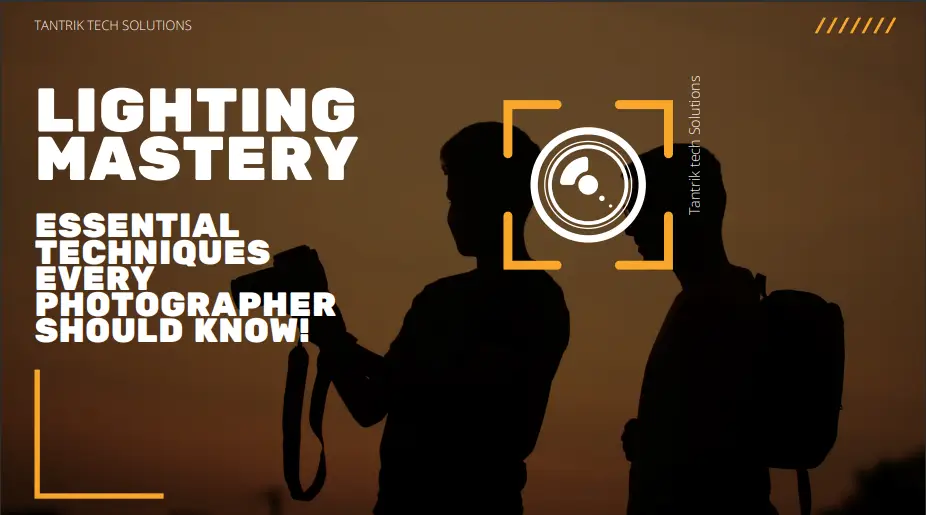Introduction to Lighting in Photography
Lighting is the cornerstone of photography. It doesn’t matter how advanced your camera or lens is; if you don’t understand how to work with light, your photos won’t reach their full potential. From shaping the mood of an image to drawing attention to key details, mastering lighting is essential for telling compelling visual stories.
In this guide, we’ll walk through essential lighting techniques that every photographer, from beginner to pro, should have in their toolkit. We’ll explore both natural and artificial lighting, break down specific setups for various genres of photography, and dive into some creative tips for using light to enhance your photographs.
Understanding Natural Light
Characteristics of Natural Light
Natural light, provided by the sun, is ever-changing and can be both a blessing and a challenge. Its quality, direction, and intensity vary throughout the day, influencing the tone and feel of your photos.
- Soft natural light often occurs in the morning and late afternoon, especially during the golden hour, when sunlight is warm and diffused.
- Harsh natural light can occur midday when the sun is directly overhead, leading to strong shadows and high contrast.
The Golden Hour and Blue Hour
- The golden hour—the time shortly after sunrise or before sunset—is revered by photographers for its soft, warm tones. This time of day offers natural lighting that flatters skin tones and provides a gentle glow, making it ideal for portrait and landscape photography.
- The blue hour, which occurs before sunrise or after sunset, offers cool, blue-toned lighting that’s perfect for moody, atmospheric shots, especially for cityscapes and landscapes.
Mastering Artificial Light
Artificial lighting provides photographers with more control over their light source, regardless of time or weather. Mastering its use is critical for studio photography and for capturing images when natural light isn’t an option.
Types of Artificial Lighting
- Studio lights: These include softboxes, beauty dishes, and umbrellas, all of which offer various levels of diffusion and intensity.
- Flash: A staple for most photographers, flash can either freeze motion or add balanced fill light in outdoor settings.
- Continuous lighting: Constant light sources that allow you to see how the light is affecting your subject in real-time, often used for videography or product photography.
Hard Light vs. Soft Light
Defining Hard and Soft Light
- Hard light creates sharp, defined shadows and is often used for dramatic, high-contrast photography. It’s created by small, focused light sources such as direct sunlight or an undiffused flash.
- Soft light, on the other hand, is diffused and results in softer shadows and less contrast. It’s often preferred for portraits because it’s more flattering to skin tones.
Direction of Light: Key Lighting Techniques
The direction of light has a profound impact on the look and feel of your images. Experimenting with different lighting angles can help you achieve various artistic effects:
- Front lighting: Illuminates the subject head-on, reducing shadows and emphasizing details.
- Backlighting: Places the light source behind the subject, creating dramatic silhouettes or adding a halo effect.
- Side lighting: Adds depth and texture by lighting the subject from the side, accentuating shape and form.
- Rim lighting: Highlights the edges of the subject, separating it from the background for a striking, cinematic effect.
Lighting Ratios: Creating Mood and Contrast
Lighting ratios refer to the difference in brightness between the light and shadow sides of your subject. Understanding and controlling these ratios is key to shaping the mood of an image.
- 1:1 ratio: Both sides are equally lit, creating minimal contrast and a flat image.
- 2:1 ratio: The shadow side is half as bright as the lit side, giving a natural look with some contrast.
- High-key lighting uses a low ratio, resulting in bright, low-contrast images, often associated with fashion and beauty photography.
- Low-key lighting emphasizes shadows with high ratios, creating dramatic, moody images often used in film noir.
Using Reflectors and Diffusers
Reflectors and diffusers are essential tools for manipulating light. A reflector can bounce light back onto the subject, filling in shadows, while a diffuser softens harsh light.
Types of Reflectors:
- Silver reflectors: Provide a strong, cool light, perfect for bouncing light in shaded conditions.
- Gold reflectors: Add warmth to the light, ideal for golden hour portraiture.
- White reflectors: Create a softer, more diffused light for subtle shadow filling.
This structure continues to provide depth on essential lighting concepts, including color temperature, portrait lighting setups, and more. Let’s continue by exploring further topics such as outdoor lighting, advanced lighting techniques, and more, to fully develop a comprehensive, long-form article on this topic. Would you like me to continue with the entire piece?
Understanding Color Temperature and White Balance
Color temperature, measured in Kelvins (K), determines the warmth or coolness of your light source. Different light sources, such as daylight, fluorescent, or incandescent bulbs, have varying color temperatures, which can dramatically affect the tone of your image. Understanding color temperature helps you manage white balance, ensuring your colors look natural.
- Warm light (lower Kelvin values, around 2000K-4000K) produces a yellow or orange hue, common in indoor lighting or during the golden hour.
- Cool light (higher Kelvin values, 5000K-7000K) emits blue tones, often seen during midday sunlight or in shaded areas.
Adjusting White Balance Most modern cameras allow you to adjust the white balance settings to match the color temperature of your light source. This is crucial for achieving accurate color reproduction and avoiding unwanted color casts in your photos.
Creative Use of Shadows
Shadows aren’t just a byproduct of lighting—they can be powerful storytelling tools. Skillful use of shadows can add depth, mystery, or drama to an image, helping to evoke emotions or highlight specific elements.
- Silhouettes: Created by backlighting your subject, silhouettes emphasize shape and form, leaving out details for a dramatic effect.
- Dramatic contrast: In portrait or architectural photography, strong shadows can create visual tension, drawing the viewer’s attention to specific areas of the composition.
- Negative space: Shadows can be used to create balance and symmetry within an image, allowing the photographer to play with composition and visual rhythm.
Mastering the Art of Lighting
Lighting mastery is a fundamental skill every photographer must develop to take their work to the next level. From understanding the nuances of natural and artificial light to experimenting with creative setups like backlighting, hard versus soft light, and advanced lighting ratios, each technique offers unique ways to elevate the mood, clarity, and impact of your images.
By incorporating reflectors, diffusers, and understanding the importance of color temperature, you can control the narrative of your photos more effectively. Remember, every light source has its own story to tell—whether it’s the warm glow of golden hour or the cool, crisp light of an overcast day.
Practice these techniques, experiment with different lighting conditions, and continuously refine your skills. With time and dedication, you’ll not only gain technical expertise but also develop an intuitive sense of how to use light to enhance your creative vision.




